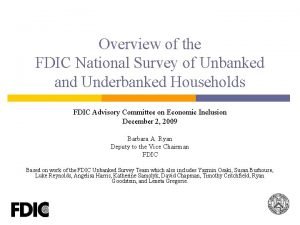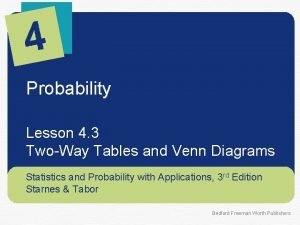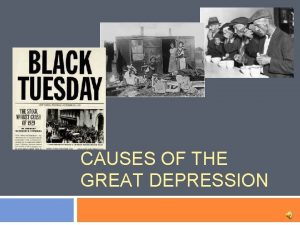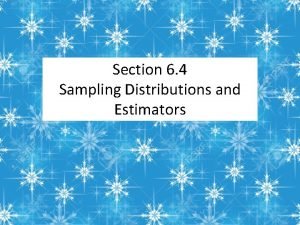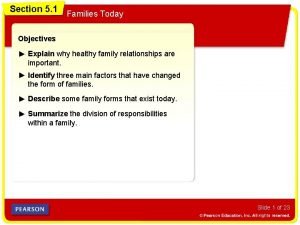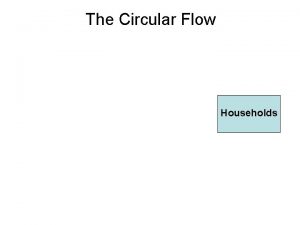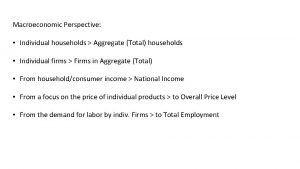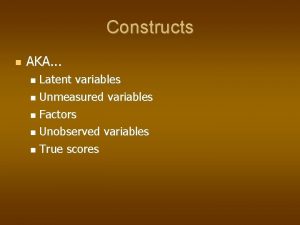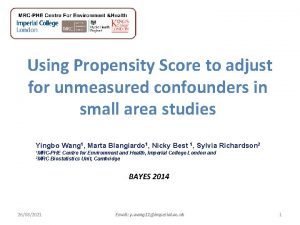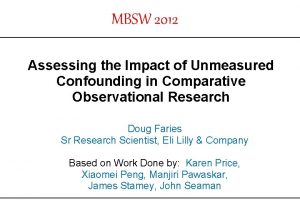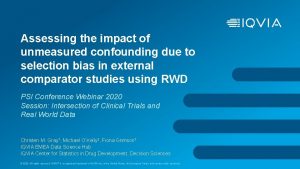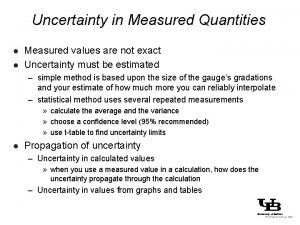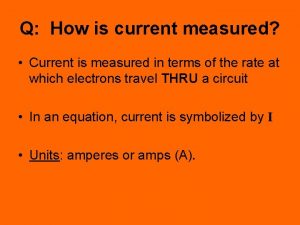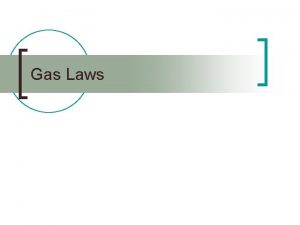From unmeasured to measured gas for households 5















- Slides: 15

From unmeasured to measured gas for households 5 th meeting ECDSO-g Coordination Platform Eva Hennig, April 2018

The Thüga Group constitutes the largest alliance of muncipal utilities in Germany Key figures 31. 12. 2016 Turnover € 19. 0 billion Investments € 1. 0 billion Gas sales 116. 8 billion k. Wh Electricity sale 49. 8 billion k. Wh Heating Sales 9. 0 billion k. Wh Water sales 277. 9 million m³ Gas customers 2. 0 million Employees 17, 200 2018 April Energy Community Workshop Vienna Heating customers 0. 1 million Electricity customers 4. 0 million Water customers 0. 9 million 2

The Thüga Group is represented all over Germany in more than 90 utility companies Partners within the Thüga Group: Kiel Hamburg Schwerin Bremen Berlin Hannover Potsdam Magdeburg Düsseldorf Erfurt Dresden Wiesbaden Mainz Saarbrücken Stuttgart München 2018 April Energy Community Workshop Vienna 3

From Non-Metered to metered residential consumers – experiences and ideas for discussion 2018 April Energy Community Workshop Vienna 4

Metering practices in the member states depend on the historical development of the legal framework Discussion: How is the situation in member states of the Energy Community Variant A: no meter, no bill • Why? Which customer groups? • How do you know which consumer is connected to the grid? • How is the consumer connected to the grid and who did it? Variant B: meter, but no bill • Why? Which customer groups? Variant C: meter exist + bill is sent , but not based on metered consumption • Why? Which customer groups? • Which assumptions are used to produce the bill? • Do the customers pay? Who is responsible for the metering? Which law regulates metering and billing? How is electricity metered? How many accidents happen through manipulation at the house installation? How is the payment willingness for those consumers with a meter? Could consumers do self-readings? 2018 April Energy Community Workshop Vienna 5

Why is it important to meter all consumers? There are many reasons aside from the current legal framework of the 3 rd package and the network codes Safety Other costumers might get „ideas“ how to avoid metering in the future Without metering data the balancing rules of the Network Code can not be applied Suppliers buy gas with metered volumes. Costs of unbilled consumers will be paid by others. DSO need grid revenues. Costs of unbilled consumers will be paid by others. Unmetered gas does not promote energy efficiency Without metering the data are missing for many processes 2018 April Energy Community Workshop Vienna 6

On the path to metering different solutions could be applied It is important to use data from reference customers as a foundation Estimation: • Consumption of small consumers with a regular profile can be estimated. Example is gas usage for cooking and hot water production • For the estimate a certain knowledge of the consumer has to be found e. g. number of hot water boilers, cooking devices Load profiles: • Depending on the type of consumer various load profiles can be used • If the gas consumption is not know the base can be the installed capacity of the heating + hot water production or the number of heaters, size of the house/apartment, number of radiators • As heating is temperature driven a relevant temperature has to be defined • The right mixture between temperature related heating consumption and non temperature hot water consumption has to be found depending on the region • ………. 2018 April Energy Community Workshop Vienna 7

There are many different load profiles used in Europe. The German residential profile depends only on the temperature 2018 April Energy Community Workshop Vienna 8

The Italian Load Profile for example takes air conditioning into account if it is done with gas 2018 April Energy Community Workshop 9

The German gas industry developed the load profiles in 1999 with the TU Munich based on metering data of real consumers The first set of profiles used a Sigmoid formula to simulate the gas consumption. After 10 years of experience and many grid calculations the formula was changed 2018 April Energy Community Workshop Vienna 10

Continuous efforts over years to increase the quality of nondaily metered costumers to reduce balancing energy of the TSO The management of load profiles needs a well oiled IT system as many data of the consumer and the weather are involved • • • Choose the right temperature Choose the right load profile Adjust the normalized daily consumption after every annual reading Correct mapping of consumer to supplier and balancing group Intense Monitoring of the grid account, that each DSO manages Utilize correction factors in case nothing works out and the grid accounts does not improve ØThe quality control of the load profiles is a daily task of every DSO ØIf differences are too big the DSO is penalized ØDue to the strict timing of the data management processes an automatic process has to implemented 2018 April Energy Community Workshop Vienna 11

The monitoring of estimates and load profiles can be done with the grid account The logic: what goes into the grid must come out, eventually, after linpack 2018 April Energy Community Workshop Vienna 12

The forecasting temperature is very important • • • The DSO chooses a temperature that is publicly available and fits the forecasting area To find the right temperature a as-if-allocation should be calculated for a year A seasonal set-off < 1, 5 °C can be added if the inflexion point proves to shift with the season • 2018 April Energy Community Workshop Vienna To have a better fit the geometric row if temperatures has proven itself 13

Load profiles in balancing – Germany has chosen Variant 2 in the Network Code Balancing Objective of the choice: trigger switching rates, allow a multitude of also small suppliers to take part in the market, standardized and enforced contracts, processes and data formats, cost-effiency for all grid users, fast implementation • Forecast of all NDM customers is done by the DSO • Everyday at 12 pm the DSO sends the data to the TSO, aggregated per balancing group • The TSO sends the data until 1 pm to the shipper • If the shipper nominates this values there will be no balancing differences • The Delta between physical flow and load profile is payed through the reconciliation which is calculated per individual consumer • But: a profile stays a statistical method and will never fit 100 % 2018 April Energy Community Workshop Vienna 14

Even in countries with a well developed metering system funny things can be found 1. Light up twice briefly with the flashlight on the light sensor. 2. Wait until "PIN" appears in the second line of the display and the number 0 appears in the first position. 3. Briefly illuminate the light sensor several times in succession until you see the first digit of your PIN (example: for the figure "3" you light up the light sensor three times in succession). 4. The sequence of numbers starts again each time (0, 1, 2, 3, 4, 5, 6, 7, 8, 9, 0, 1, 2, 3. . . ). Wait three seconds, the entry will jump to the next position. 5. Repeat the process for the other digits of the PIN. 6. If you have accidentally entered a wrong PIN, the second display line will remain off. Please repeat the process. 7. After successful PIN entry, the second line of the display is permanently activated and shows the current performance. You can now display your individual consumption values at any time without re-entering your PIN by briefly flashing the light sensor. You can reactivate the PIN input at any time and thus switch off the second display line to protect your individual consumption values. 2018 April Energy Community Workshop Vienna 15
 Unmeasured anions
Unmeasured anions National survey of unbanked and underbanked households
National survey of unbanked and underbanked households Venn diagram and two way tables
Venn diagram and two way tables Households and firms circular flow model
Households and firms circular flow model Paradox in romeo and juliet
Paradox in romeo and juliet In 1929 the top 5 percent of all american households
In 1929 the top 5 percent of all american households Two households, both alike in dignity.
Two households, both alike in dignity. Three randomly selected households are surveyed 2 6 7
Three randomly selected households are surveyed 2 6 7 Two households end
Two households end Alike in dignity
Alike in dignity Prologue of romeo and juliet
Prologue of romeo and juliet Prologue romeo and juliet meaning
Prologue romeo and juliet meaning Today more than half of all mothers with preschool
Today more than half of all mothers with preschool Reaksi pembentukan gas no2f dari gas no2 dan f2
Reaksi pembentukan gas no2f dari gas no2 dan f2 Sutherland's law
Sutherland's law Flue gas desulfurisation gas filter
Flue gas desulfurisation gas filter

